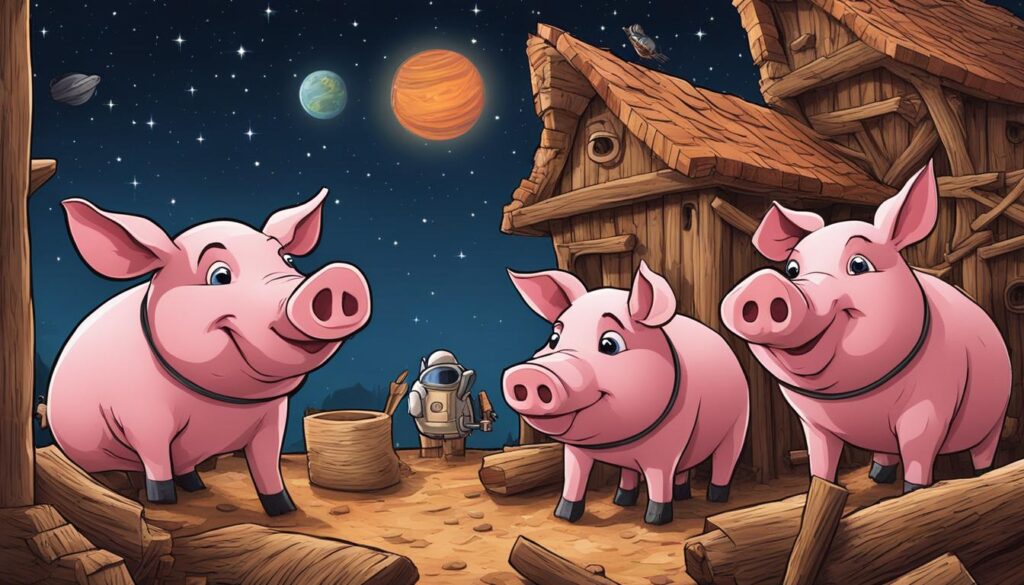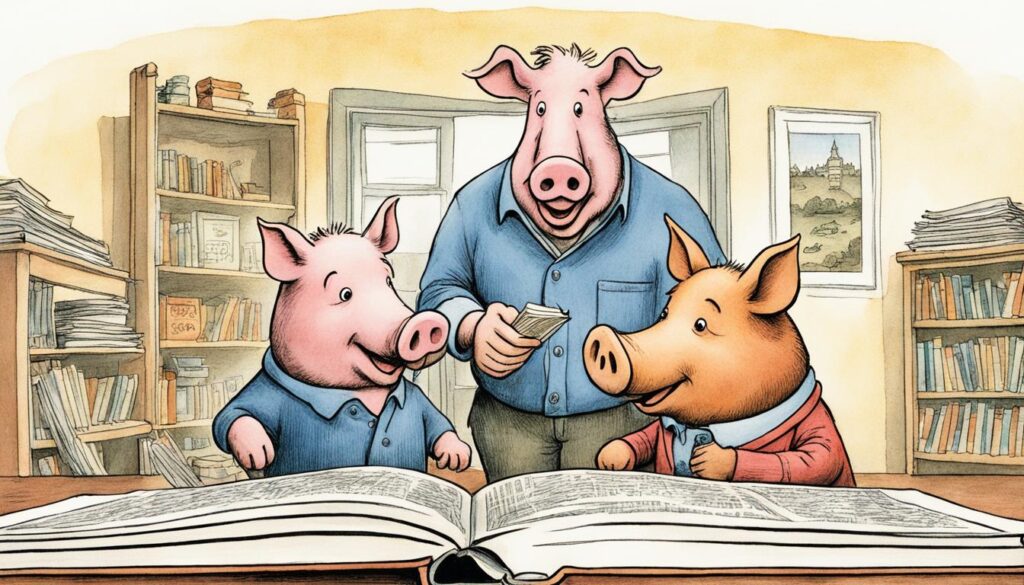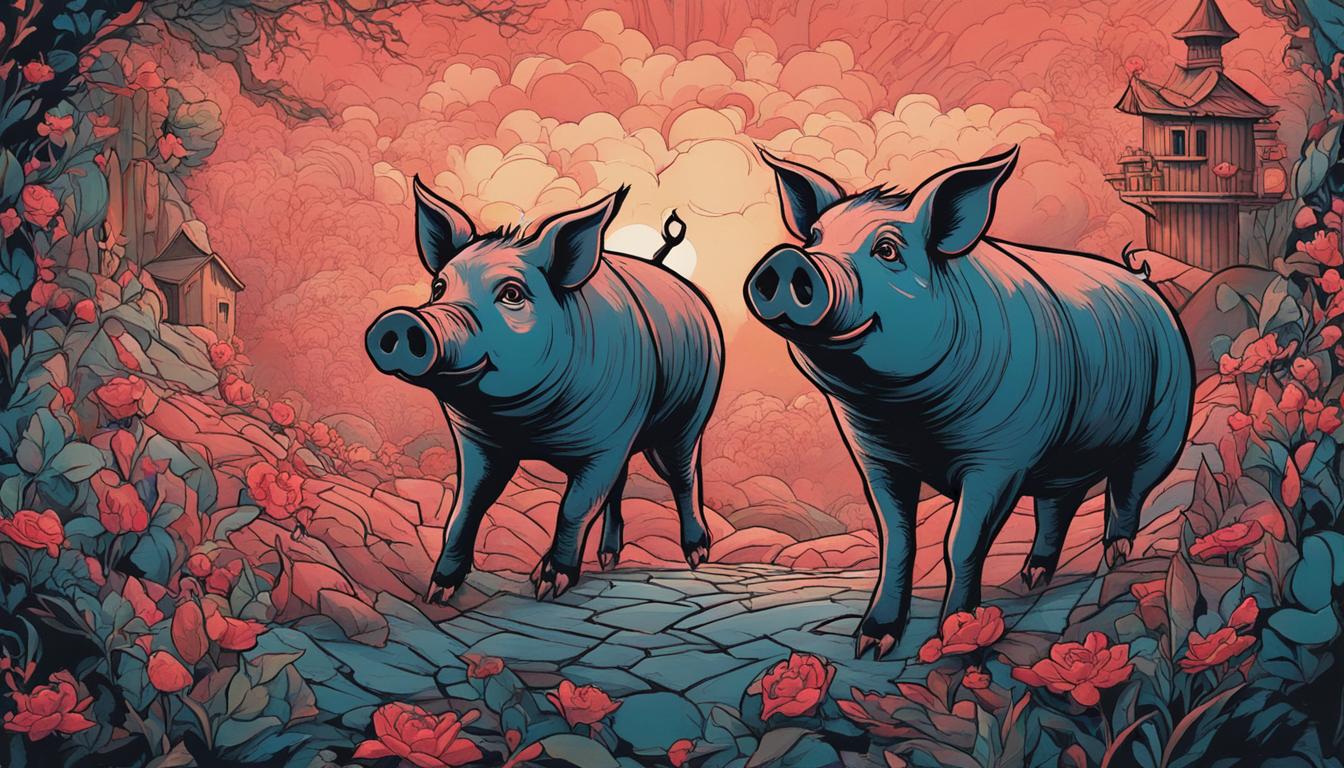David Wiesner’s ‘The Three Pigs’ is a modern retelling of the classic fairy tale. Through a series of imaginative twists, the author takes readers on a mesmerizing adventure that will leave them spellbound.
The book’s intricate illustrations and inventive storytelling have made it a favorite among children and adults alike. David Wiesner’s unique approach to storytelling is evident in his other notable works, including ‘Tuesday’ and ‘Flotsam.’
Key Takeaways
- ‘The Three Pigs’ is a modern retelling of the classic fairy tale.
- David Wiesner’s imaginative twists make the book a mesmerizing adventure.
- The book’s intricate illustrations and inventive storytelling have made it a favorite among both children and adults.
- David Wiesner’s other notable works include ‘Tuesday’ and ‘Flotsam.’
About the Author
David Wiesner is an American author and illustrator known for his engaging and imaginative children’s books. Born in Bridgewater, New Jersey, in 1956, Wiesner has been writing and illustrating since he was a child. He attended the Rhode Island School of Design, where he received his Bachelor of Fine Arts in Illustration.
Wiesner is a three-time winner of the prestigious Caldecott Medal, which is awarded annually by the Association for Library Service to Children. He received his first award in 1992 for his book ‘Tuesday’ and then won the Caldecott Medal again in 2002 for ‘The Three Pigs.’ His third award came in 2007 for his book ‘Flotsam.’
In addition to these accolades, Wiesner has received numerous other awards and recognition for his work. He has also illustrated books for other authors, including Lois Lowry and Jack Prelutsky. His books have been translated into more than a dozen languages and have sold millions of copies worldwide.
David Wiesner’s dedication to crafting compelling stories and captivating illustrations has made him a beloved figure in the world of children’s literature. He continues to write and create to this day, inspiring a new generation of young readers and artists.
Overview of ‘The Three Pigs’
In David Wiesner’s ‘The Three Pigs’, readers are transported into a world of imaginative storytelling. The book is a modern retelling of the classic folktale of three pigs building houses to protect themselves from a hungry wolf. In this version, however, the pigs don’t simply run to their nearest home; they embark on a journey that involves balloons, airplanes, and even a dragon.
The story begins with the pigs’ desire to leave their old tale as they break the fairy tale book’s pages and venture into the unknown. They build the first house, which is blown down by a wolf, and then they proceed to take to the air in a makeshift airplane. In the end, the three pigs build their metal home, which the wolf cannot blow down.
Children will enjoy the imaginative twists and turns as they explore new ways of thinking about the familiar folk tale. Through this playful and educational approach, the book engages readers and teaches valuable lessons about determination and problem-solving.
The Imaginative Twists
‘The Three Pigs’ by David Wiesner is a masterful retelling of the classic tale that subverts our expectations and keeps readers engaged from beginning to end. Wiesner takes the familiar story and adds imaginative twists that inject new life into the narrative.
One of the most striking twists is the decision to have the pigs venture out of the storybook and into other fictional worlds. This clever device reminds readers of the power of books to transport us to different places and times, and allows Wiesner to flex his creative muscles by presenting the pigs with new and exciting challenges.’
The impact of these imaginative twists cannot be overstated. By taking a well-known story and reshaping it in unexpected ways, Wiesner has crafted a book that feels both fresh and timeless. It is a testament to the author’s skill that he is able to breathe new life into a story that has been told countless times before.

Themes Explored
In ‘The Three Pigs,’ David Wiesner explores several themes that can help readers develop a deeper understanding of the story. One of the central themes is resilience. Despite facing challenges, the pigs are able to adapt and overcome their obstacles. This theme can teach children the importance of persevering through difficult situations.
Another theme present in the book is the power of imagination. As the pigs enter new worlds through the pages of their tale, they learn to think creatively and resourcefully. This theme can inspire children to explore their imaginations and to embrace their innate sense of creativity.
The theme of friendship is also present in ‘The Three Pigs.’ As the pigs work together to outsmart the wolf, they learn the benefits of collaboration and teamwork. This theme can teach children important social skills that they can use in their everyday lives.
Overall, ‘The Three Pigs’ is a richly thematic work that explores important issues like resilience, imagination, and friendship. These themes can help children learn important life skills and develop a deeper appreciation of the value of these traits.
Artistic Style
In ‘The Three Pigs,’ David Wiesner’s artistic style is a significant aspect of the book’s appeal. The illustrations are beautifully crafted, with attention to detail evident in every scene.
Wiesner employs a combination of watercolor, pencil, and ink to create a dreamlike atmosphere that feels both real and imagined. The colors are a blend of muted tones that evoke emotion and convey the mood of the story. The overall effect is nothing short of enchanting.
Each page of the book is a work of art in its own right, with the images telling as much of the story as the words. There are no traditional panel borders, allowing the illustrations to flow freely across the pages. This approach adds to the feeling of being transported into a magical world.
The artistic style in ‘The Three Pigs’ emphasizes the book’s imaginative storytelling and reinforces its theme of the power of imagination. The illustrations are an integral part of the book’s success, making it a must-read for anyone who appreciates the art of storytelling.
Reception and Awards
‘The Three Pigs’ has received widespread acclaim since its publication, garnering several awards and nominations from notable literary organizations. The book has been praised for its imaginative storytelling, stunning artwork, and unique reimagining of the classic tale.
| Award | Year | Category |
|---|---|---|
| Caldecott Medal | 2002 | Winner |
| Boston Globe-Horn Book Award | 2002 | Winner |
| ALA Notable Children’s Book | 2002 | Winner |
| Booksense 76: Top 10 Children’s Picks | 2002 | Winner |
| National Book Award Nomination | 2001 | Nominated |
The recognition ‘The Three Pigs’ has received underscores its significance in the world of children’s literature and its lasting impact on readers of all ages.
Impact on Children’s Literature
‘The Three Pigs’ has made a significant impact on children’s literature, particularly in its innovative approach to storytelling and illustration. The book’s creative twists on the traditional fairy tale have influenced the way authors and illustrators approach children’s literature, encouraging them to think outside the box and push the boundaries of traditional storytelling techniques.
The book’s impact goes beyond its artistic and literary innovations; it also has important educational value, as it teaches children valuable life lessons in an engaging and memorable way. Through its exploration of themes such as resilience, problem-solving, and creative thinking, ‘The Three Pigs’ has become a staple in classrooms and libraries worldwide, helping young readers develop critical thinking skills and a love of reading.
The broader literary landscape has also been influenced by ‘The Three Pigs’. Its popularity has inspired many adaptations and retellings of classic fairy tales, as well as new works that incorporate similar artistic and literary techniques. It has undoubtedly left a lasting impact on the world of children’s literature and storytelling as a whole.
Educational Value
‘The Three Pigs’ by David Wiesner is an excellent book for children’s education. It offers various learning opportunities. One of the most significant educational values of this book is teaching children to think creatively. It challenges the conventional storytelling and inspires children to think outside the box. Children learn that they can take a traditional story and give it a unique twist to make it their own.
Moreover, this book is ideal for teaching story elements such as plot, setting, and characters. Children can identify and describe the different elements of the story. Additionally, the imaginative twists in the book make it a perfect tool for teaching critical thinking and problem-solving skills. Children can analyze the story and identify the challenges faced by the characters, how they solved them, and the consequences of their actions.
| Educational Value of ‘The Three Pigs’ | Skills Taught |
|---|---|
| Encourages creativity | Creative thinking |
| Teaches story elements | Plot, Setting, Characters |
| Enhances critical thinking skills | Problem-solving |
The book’s artistic style also makes it an excellent tool for teaching visual literacy. Children can observe the illustrations and analyze how they contribute to the story’s meaning and message. Moreover, the book’s lack of text challenges children’s reading abilities, promoting reading comprehension and fluency.
Overall, ‘The Three Pigs’ has enormous educational value for children. It offers a unique approach to storytelling that promotes creativity, critical thinking, and problem-solving skills. It also teaches story elements and enhances visual literacy and reading abilities. Educators can use this book to teach a range of concepts and skills, making it an invaluable tool in the classroom.
Reader’s Response
Readers have had overwhelmingly positive reactions to ‘The Three Pigs’. Many have praised Wiesner’s inventive storytelling and unique artistic style.
One reader, Sarah, wrote, “I read ‘The Three Pigs’ to my kindergarten class, and they were mesmerized! The illustrations are breathtaking, and the story captivates young and old alike.”
Another reader, Tom, said, “I’ve read ‘The Three Pigs’ to my daughter countless times, and we still discover something new every time we read it. It’s a masterpiece of children’s literature.”
The book has received numerous awards and recognitions, including the Caldecott Medal. It has cemented its place in children’s literature and continues to inspire and delight readers of all ages.

Conclusion
In conclusion, David Wiesner’s ‘The Three Pigs’ is a creative retelling of the classic tale. Wiesner’s imaginative twists and unique artistic style make the book a standout in children’s literature.
Through the book’s themes and underlying messages, readers are exposed to valuable lessons and concepts. ‘The Three Pigs’ has also made a significant impact on the literary landscape, influencing other authors and storytelling techniques.
With its educational value and positive reception from readers and critics alike, ‘The Three Pigs’ is a must-read for anyone interested in children’s literature. We highly recommend this book to parents, educators, and anyone passionate about storytelling and creative expression.



